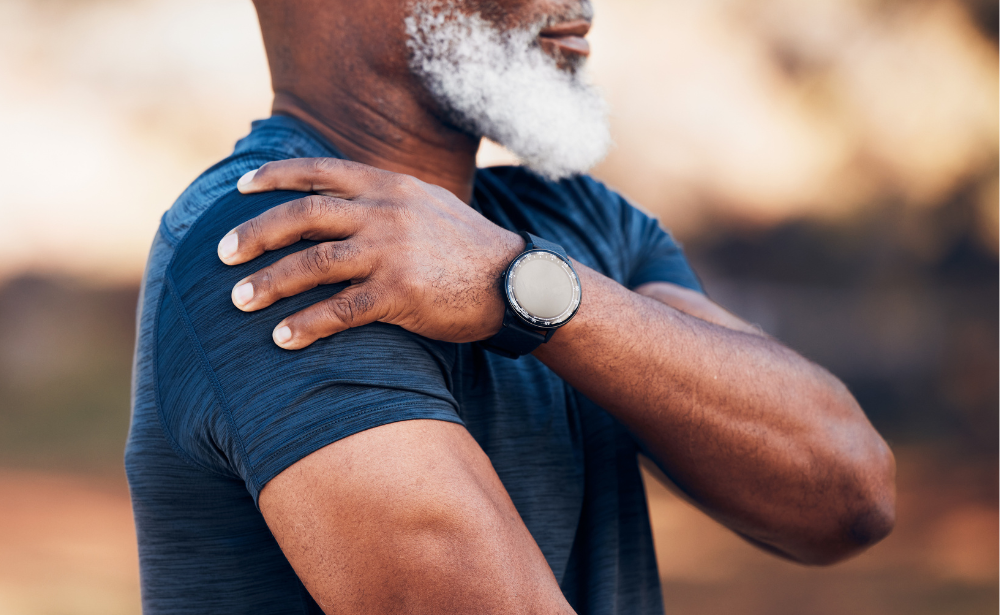Shoulder Surgery Recovery
Move Better. Live Fuller. Your Wellness Journey Starts Here.
Schedule a FREE Discovery Call!
About Shoulder Surgery
The shoulder has a wide range of motion so that it can perform a multitude of actions. It comprises two joints: a ball-and-socket joint known as the glenohumeral joint, which includes the humerus and scapula, and the acromioclavicular joint, which includes the scapula and collar bone. These joints allow for a lot of motion, but are prone to instability as a result.
Due to injury, inefficient movement, or prolonged use, your shoulder can become weak, stiff, and lack range of movement. It can become painful to move, less functional, and the structures can become damaged if not properly addressed.
If you begin to experience shoulder pain that is constant or recurring—or a loss of movement to some degree—you need to seek treatment. Shoulder pain or complications should not be ignored, as they can worsen with time.

Additionally, if you begin to think you may need shoulder surgery for your condition, it is very important to be proactive in your health and seek physical therapy beforehand. While physical therapy will be necessary after surgery to return to normal function, preparing your body beforehand is also extremely beneficial! Physical therapy can help optimize your strength, flexibility, and control at your arm, shoulder, neck, and back. By seeking pre-operative physical therapy, you will help minimize post-surgical complications and be more proactive in healing your condition.
Not every condition will necessarily lead to shoulder surgery. Surgery is usually considered an option when other conservative treatments have failed to provide relief. It may be necessary if the structural damage to the shoulder is such that nonsurgical treatments are unlikely to be effective. Every person’s case may vary, but some conditions or injuries that may lead to shoulder surgery can include the following:
- Rotator cuff tears: These are tears in the muscles and tendons that stabilize the shoulder. Surgery may be needed to repair the tear, especially if it is large or if other treatments have not provided relief.
- Shoulder impingement syndrome: This condition occurs when the acromioclavicular joint (the junction between the scapula and collar bone) puts pressure on the underlying soft tissues when the arm is lifted upwards.
- Frozen shoulder or adhesive capsulitis: In some severe cases where the shoulder becomes very stiff and painful, surgery may be considered to release the joint capsule.
- Shoulder instability or dislocations: If the shoulder joint becomes loose and/or frequently dislocates, surgery may be required to repair or tighten the ligaments and capsule holding it in place.
- Arthritis of the shoulder: Severe shoulder arthritis may lead to the need for shoulder replacement surgery, wherein the damaged parts of the shoulder are replaced with artificial components.
- Labral tears: These are tears of the cartilage around the rim of the shoulder socket that may require surgery to repair, especially if they cause persistent pain or shoulder instability.
- Fractures: Severe fractures of the shoulder bones (such as the humerus, clavicle or scapula) might require surgical intervention to properly align and fixate the bones for healing.
- Bursitis: In chronic cases where the bursa (a lubricating SAC between muscles and tendons in the joint) repeatedly becomes inflamed, surgery may be considered to remove it.
- Tendonitis: Persistent or severe tendonitis in the shoulder that does not respond to conservative treatments might lead to surgery to repair the damaged tendons.
As previously mentioned, shoulder surgery is not always required for all conditions, but depending on your specific condition, it may be necessary. It depends on several factors, including your particular diagnosis, severity of symptoms, your overall health, and response to nonsurgical treatments.
What to Expect After Shoulder Surgery
Shoulder surgery recovery varies greatly with the individual, the type of surgery received, and compliance with post-surgery care. Close communication between the surgeon, physical therapist, and patient is essential for a safe and effective recovery process. Every person’s recovery experience will be different, but there are stages of recovery you can generally expect after shoulder surgery:
Immediate Post Operative
The period immediately after your operation will be mostly rest and recovery. You’ll experience some level of pain and discomfort, which is normal. You’ll likely receive prescriptions for pain medication to manage it.
During this healing process, your arm may be immobilized in a sling or brace, but the duration varies by the type of shoulder surgery and the surgeon’s protocol. Swelling and bruising of the surgical area are common. Lastly, you will be given instructions to care for your incision, such as keeping it dry and clean.
Early Recovery Phase
- Physical therapy begins: Early-stage physical therapy often starts soon after surgery to maintain range of motion and prevent stiffness. Initially, exercises may be passive (the therapist moves your arm), gradually progressing to active exercises as healing progresses.
- Gradual increase in activity: You’ll be advised on when and how to gradually increase your activities. This typically begins with daily activities and later progresses to more strenuous tasks.
- Pain management transition: As you recover, you will likely transition from prescription pain medication to over-the-counter pain relief options. Additionally, physical therapy can educate you on other pain relief modalities, such as ice, heat, electrical stimulation, and dry needling.
Mid to Late Recovery Phase
- Regaining strength and mobility: This phase, which can take several months, focuses on strengthening the shoulder muscles, improving flexibility, and increasing the range of motion.
- Returning to daily activities: You’ll gradually be able to return to more of your daily activities and possibly work, depending on the physical demands of your job.
- Continuing physical therapy: Physical therapy is crucial for regaining full function and preventing future injuries. At this stage, your physical therapy will gradually become more challenging.
Long Term Recovery
Complete healing and the return to normal activity (including sports) can take anywhere from six months to a year. Again, the recovery time depends on your specific shoulder surgery, how well you adhere to rehabilitation protocols, and the comprehensive care plan outlined by your physical therapist. You can expect regular follow-up appointments with your surgeon and physical therapist to monitor your progress and address any concerns.
Tips for Efficient Shoulder Surgery Recovery
- Always adhere to your surgeon’s and physical therapist’s post-operative instructions.
- Set realistic expectations. Recovery can be a slow process, but it is essential that you are patient with your progress to ensure proper recovery.
- Be sure to report any concerns or unusual symptoms to your providers immediately. Proper and timely communication is important.
Physical Therapy For Shoulder Surgery Recovery
As with most surgeries, physical therapy plays a crucial role in the recovery process after shoulder surgery. It helps in various ways to ensure a successful recovery, improve shoulder function, and reduce pain. Avoiding physical therapy can result in a longer healing time, less range of motion, weak muscles, and an increased likelihood of future injury.
Physical therapy usually starts with gentle exercises and gradually progresses to more challenging activities as your condition improves. The specific timeline and types of exercises used in physical therapy will depend upon the nature of the surgery, your individual condition, and the surgeon’s protocols.
Here are some of the key ways physical therapy can help with shoulder surgery recovery:
- Pain management: The use of modalities like ice, heat, and electrical stimulation can reduce postoperative pain and inflammation.
- Reducing swelling: Physical therapy techniques such as manual lymphatic drainage and compression can reduce swelling in the shoulder area, which is a common post-surgery symptom.
- Restoring range of motion: Due to immobilization after surgery, the shoulder may become stiff. Physical therapists use passive, active assistive, and active exercises to gradually increase the range of motion as the healing process allows.
- Strengthening muscles: Once the shoulder has healed sufficiently, a physical therapist will introduce exercises to strengthen the shoulder muscles and the surrounding areas. This is crucial for regaining function and supporting the joint.
- Improving flexibility: Stretching exercises improve the flexibility of the shoulder joint and surrounding muscles, which is essential for a full recovery and to prevent future injuries.
- Enhancing proprioception: Proprioception is the body’s ability to perceive its own position in space. Physical therapy includes neuromuscular re-education movements and exercises that improve proprioceptive awareness, which is important for joint stability and coordination.
- Education on activity modifications: Physical therapists provide guidance on behavioral modifications, activity modification, and ergonomics to prevent shoulder strain during daily activities and work tasks.
- Preventing scar tissue: Physical therapy techniques such as manual therapy, cupping, dry needling, and personalized exercises minimize the formation of restrictive scar tissue, which can limit shoulder mobility.
- Improving functional abilities: The ultimate goal of physical therapy is to return you to your pre-injury level of function. This includes tailored exercises and activities that simulate your daily tasks or sport-specific movements.
- Developing a home exercise program: Physical therapists design personalized home exercise programs that you can perform to continue your rehabilitation process outside of therapy sessions.
Your provider may utilize various techniques tailored to your specific needs to achieve these results during physical therapy. Some physical therapy treatments that may be used to improve shoulder surgery recovery may include:
- Dry needling
- Cupping
- Manual therapy
- Spinal manipulation
- Electrical muscle stimulation
- Tissue scraping
- Exercise prescription
- Behavioral modifications
- Therapeutic modalities
- Neuromuscular re-education
- Biofeedback
- Therapeutic activity
The shoulder has a wide range of motion so that it can perform a multitude of actions.
It comprises two joints: a ball-and-socket joint known as the glenohumeral joint, which includes the humerus and scapula, and the acromioclavicular joint, which includes the scapula and collar bone.
These joints allow for a lot of motion, but are prone to instability as a result.
Due to injury, inefficient movement, or prolonged use, your shoulder can become weak, stiff, and lack range of movement.
It can become painful to move, less functional, and the structures can become damaged if not properly addressed.
If you begin to experience shoulder pain that is constant or recurring—or a loss of movement to some degree—you need to seek treatment. Shoulder pain or complications should not be ignored, as they can worsen with time.
Additionally, if you begin to think you may need shoulder surgery for your condition, it is very important to be proactive in your health and seek physical therapy beforehand.
While physical therapy will be necessary after surgery to return to normal function, preparing your body beforehand is also extremely beneficial!
Physical therapy can help optimize your strength, flexibility, and control at your arm, shoulder, neck, and back.
By seeking pre-operative physical therapy, you will help minimize post-surgical complications and be more proactive in healing your condition.
Not every condition will necessarily lead to shoulder surgery. Surgery is usually considered an option when other conservative treatments have failed to provide relief.
It may be necessary if the structural damage to the shoulder is such that nonsurgical treatments are unlikely to be effective. Every person’s case may vary, but some conditions or injuries that may lead to shoulder surgery can include the following:
Rotator cuff tears
These are tears in the muscles and tendons that stabilize the shoulder. Surgery may be needed to repair the tear, especially if it is large or if other treatments have not provided relief.
Shoulder impingement syndrome
This condition occurs when the acromioclavicular joint (the junction between the scapula and collar bone) puts pressure on the underlying soft tissues when the arm is lifted upwards.
Frozen shoulder or adhesive capsulitis
In some severe cases where the shoulder becomes very stiff and painful, surgery may be considered to release the joint capsule.
Shoulder instability or dislocations
If the shoulder joint becomes loose and/or frequently dislocates, surgery may be required to repair or tighten the ligaments and capsule holding it in place.
Arthritis of the shoulder
Severe shoulder arthritis may lead to the need for shoulder replacement surgery, wherein the damaged parts of the shoulder are replaced with artificial components.
Labral tears
These are tears of the cartilage around the rim of the shoulder socket that may require surgery to repair, especially if they cause persistent pain or shoulder instability.
Fractures
Severe fractures of the shoulder bones (such as the humerus, clavicle or scapula) might require surgical intervention to properly align and fixate the bones for healing.
Bursitis
In chronic cases where the bursa (a lubricating SAC between muscles and tendons in the joint) repeatedly becomes inflamed, surgery may be considered to remove it.
Tendonitis
Persistent or severe tendonitis in the shoulder that does not respond to conservative treatments might lead to surgery to repair the damaged tendons.
As previously mentioned, shoulder surgery is not always required for all conditions, but depending on your specific condition, it may be necessary.
It depends on several factors, including your particular diagnosis, severity of symptoms, your overall health, and response to nonsurgical treatments.
Shoulder surgery recovery varies greatly with the individual, the type of surgery received, and compliance with post-surgery care. Close communication between the surgeon, physical therapist, and patient is essential for a safe and effective recovery process.
Every person’s recovery experience will be different, but there are stages of recovery you can generally expect after shoulder surgery:
Immediate Post Operative
The period immediately after your operation will be mostly rest and recovery. You’ll experience some level of pain and discomfort, which is normal. You’ll likely receive prescriptions for pain medication to manage it.
During this healing process, your arm may be immobilized in a sling or brace, but the duration varies by the type of shoulder surgery and the surgeon’s protocol.
Swelling and bruising of the surgical area are common. Lastly, you will be given instructions to care for your incision, such as keeping it dry and clean.
Early Recovery Phase
Physical therapy begins:
Early-stage physical therapy often starts soon after surgery to maintain range of motion and prevent stiffness. Initially, exercises may be passive (the therapist moves your arm), gradually progressing to active exercises as healing progresses.
Gradual increase in activity:
You’ll be advised on when and how to gradually increase your activities. This typically begins with daily activities and later progresses to more strenuous tasks.
Pain management transition:
As you recover, you will likely transition from prescription pain medication to over-the-counter pain relief options. Additionally, physical therapy can educate you on other pain relief modalities, such as ice, heat, electrical stimulation, and dry needling.
Mid to Late Recovery Phase
Regaining strength and mobility:
This phase, which can take several months, focuses on strengthening the shoulder muscles, improving flexibility, and increasing the range of motion.
Returning to daily activities:
You’ll gradually be able to return to more of your daily activities and possibly work, depending on the physical demands of your job.
Continuing physical therapy:
Physical therapy is crucial for regaining full function and preventing future injuries. At this stage, your physical therapy will gradually become more challenging.
Long Term Recovery
Complete healing and the return to normal activity (including sports) can take anywhere from six months to a year.
Again, the recovery time depends on your specific shoulder surgery, how well you adhere to rehabilitation protocols, and the comprehensive care plan outlined by your physical therapist.
You can expect regular follow-up appointments with your surgeon and physical therapist to monitor your progress and address any concerns.
Tips for Efficient Shoulder Surgery Recovery
- Always adhere to your surgeon’s and physical therapist’s post-operative instructions.
- Set realistic expectations. Recovery can be a slow process, but it is essential that you are patient with your progress to ensure proper recovery.
- Be sure to report any concerns or unusual symptoms to your providers immediately. Proper and timely communication is important.
As with most surgeries, physical therapy plays a crucial role in the recovery process after shoulder surgery. It helps in various ways to ensure a successful recovery, improve shoulder function, and reduce pain.
Avoiding physical therapy can result in a longer healing time, less range of motion, weak muscles, and an increased likelihood of future injury.
Physical therapy usually starts with gentle exercises and gradually progresses to more challenging activities as your condition improves. The specific timeline and types of exercises used in physical therapy will depend upon the nature of the surgery, your individual condition, and the surgeon’s protocols.
Here are some of the key ways physical therapy can help with shoulder surgery recovery:
Pain management
The use of modalities like ice, heat, and electrical stimulation can reduce postoperative pain and inflammation.
Reducing swelling
Physical therapy techniques such as manual lymphatic drainage and compression can reduce swelling in the shoulder area, which is a common post-surgery symptom.
Restoring range of motion
Due to immobilization after surgery, the shoulder may become stiff. Physical therapists use passive, active assistive, and active exercises to gradually increase the range of motion as the healing process allows.
Strengthening muscles
Once the shoulder has healed sufficiently, a physical therapist will introduce exercises to strengthen the shoulder muscles and the surrounding areas. This is crucial for regaining function and supporting the joint.
Improving flexibility
Stretching exercises improve the flexibility of the shoulder joint and surrounding muscles, which is essential for a full recovery and to prevent future injuries.
Enhancing proprioception
Proprioception is the body’s ability to perceive its own position in space. Physical therapy includes neuromuscular re-education movements and exercises that improve proprioceptive awareness, which is important for joint stability and coordination.
Education on activity modifications
Physical therapists provide guidance on behavioral modifications, activity modification, and ergonomics to prevent shoulder strain during daily activities and work tasks.
Preventing scar tissue
Physical therapy techniques such as manual therapy, cupping, dry needling, and personalized exercises minimize the formation of restrictive scar tissue, which can limit shoulder mobility.
Improving functional abilities
The ultimate goal of physical therapy is to return you to your pre-injury level of function. This includes tailored exercises and activities that simulate your daily tasks or sport-specific movements.
Developing a home exercise program
Physical therapists design personalized home exercise programs that you can perform to continue your rehabilitation process outside of therapy sessions.
Your provider may utilize various techniques tailored to your specific needs to achieve these results during physical therapy. Some physical therapy treatments that may be used to improve shoulder surgery recovery may include:
- Dry needling
- Cupping
- Manual therapy
- Spinal manipulation
- Electrical muscle stimulation
- Tissue scraping
- Exercise prescription
- Behavioral modifications
- Therapeutic modalities
- Neuromuscular re-education
- Biofeedback
- Therapeutic activity
You can learn more about these treatments on our Treatments Page.





